No matter what sort of tire damage you’ve noticed on your car, sidewall damage, in particular, can be very troublesome.
Whether you’ve been in an accident or have suddenly noticed cracks in your sidewall, you may be wondering if it’s time to replace your tires or if you can rectify the damage with a repair. Keep reading below for everything you need to know!
Sidewall tire damage is any sort of cracking or splitting that occurs to the side of the tire. This damage can occur due to an accident, defect of aging, or even everyday wear. Sadly, this sort of damage cannot be repaired and is considered dangerous. Because sidewalls do not have steel cables, any sort of damage can quickly progress and be unsafe to drive on.
Keep reading below to learn how to prevent sidewall damage, why you shouldn’t attempt to patch it, and more!
You should never drive around with sidewall damage. While driving, the damage to your sidewall can quickly become worse. After the integrity of the tire has been compromised, things can go downhill rather quickly.
Plus, sidewall damage can also lead to blowouts. As you might imagine, this can cause damage to your vehicle, as well as put you and others in danger.
For the most part, there isn’t a level of sidewall damage that is okay. You never know when even a tiny problem will suddenly become severe and lead to a blowout. Even simple driving can make the wound much worse very quickly.
Furthermore, damage to your tire sidewall can also lead to handling issues. Because the tire has been compromised, your car may not handle as well as it did previously. Even if your tire doesn’t blow, poor handling can lead to an accident.
Remember, a tire’s sidewall is one of the most vulnerable. Unlike other parts of the tire, the sidewall does not have any cords holding it together. In other words, it is just rubber.
Therefore, a little bit of damage can quickly become more severe with regular use.
Technically, sidewalls can be repaired. In most cases, you can find someone willing to repair a sidewall.
However, these repairs are not typically very effective and do not last very long. Even when repaired, you never know when your tire’s sidewall will give out again, potentially leading to a blowout and accident.
For this reason, it is not advised to drive on a tire with sidewall damage – even if that damage has technically been repaired.
While a tire’s tread can be patched, the sidewall is weaker because it does not contain any cords. In other words, it’s just plain rubber, which isn’t very stable after it’s been damaged.
Usually, it is in your best interest to replace the whole tire. While this is more costly, patches simply can’t stand up to the stress suffered by the sidewall.
Simply put, you can’t. At least, you can’t safely.
With that said, there are some directions online for fixing sidewall cracks and similar problems. However, these repairs are not recommended, as they don’t last long and can cause blowouts at any point.
However, these repairs are not recommended, as they don’t last long and can cause blowouts at any point.
While tread repairs are possible, sidewalls do not have steel cables. Therefore, their integrity is severely compromised after cracks or other sorts of damage.
For this reason, I highly recommend just purchasing a new tire if your sidewall becomes damaged. While it might be more expensive, it is much safer.
Sidewall damage can occur for many different reasons – from tire age to accidents.
Firstly, underinflation of the wheel can cause sidewall damage. Luckily, most cars today have monitoring systems that let you know when your car’s tire is underinflated. However, you should still regularly check the inflation level.
After all, you never know when your car’s internal monitoring system will malfunction.
Secondly, tires become more susceptible to damage as they age, including sidewall damage. After many years of use, the rubber may simply break down to the point that it cracks.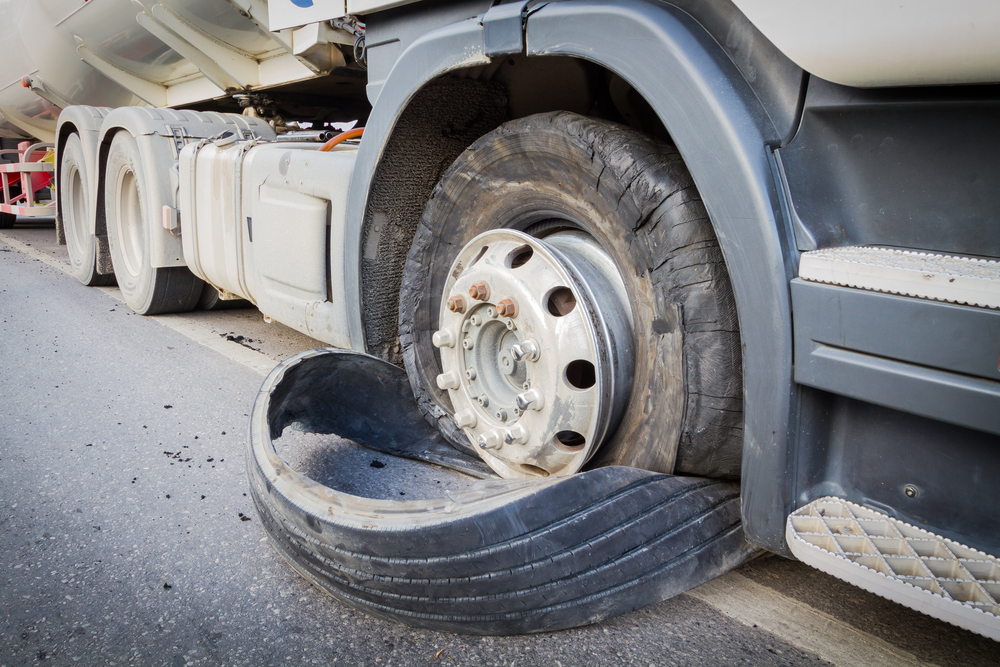
Technically, nothing caused this damage. Instead, it is just a symptom of the tire’s age.
Thirdly, overloading your tires can cause them to bow too much, leading to cracks and similar damage on the sidewall. Furthermore, overloading can make your vehicle wobble, which can also cause sidewall damage.
Be sure not to exceed your tire’s load.
Furthermore, regular tire wear can cause sidewall damage. If your tire is worn and overused, the rubber may not be very strong, making it more prone to damage.
Of course, something still has to typically hit your sidewall for it to crack in this instance.
Finally, hitting curbs and similar obstacles at high speeds can also cause sidewall damage. In most cases, the damage starts minor and then becomes worse as you drive around.
Typically, a simple examination will let you know if your sidewall is damaged. Cracks and punctures are pretty easy to see with the naked eye, even if you aren’t a trained expert.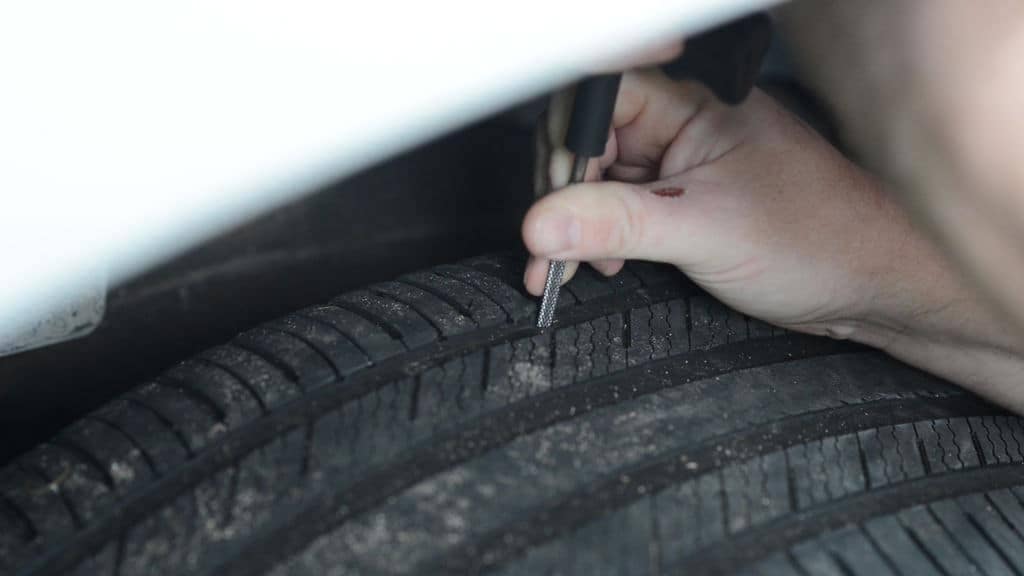
With that said, indents are typically standard and shouldn’t affect performance. These indents are caused by the fabric cords that cover the inside of the sidewall. Where these cords intersect, there may be a slight indent.
Again, this is normal and nothing to worry about.
On the other hand, bulges and bubbles are a sign of underlying cord damage. Sadly, this sort of damage cannot be repaired. Therefore, you must replace the whole tire – preferably as quickly as possible.
Significantly, you should never drive on a tire with potential sidewall damage. In many cases, this damage is highly prone to bursting, as sidewalls are not very strong.
Under most definitions, the sidewall of a tire is the side of the tire, as you might guess from the name. Pretty easy to remember.
In actuality, the sidewall doesn’t do much. Its primary purpose is to protect the cord body on the inside.
Furthermore, meaningful information about the tire is often also printed onto the sidewall.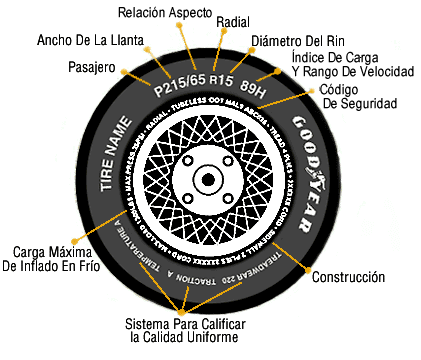 Usually, this information includes the tire’s size, load capabilities, and speed rating.
Usually, this information includes the tire’s size, load capabilities, and speed rating.
Because sidewalls are exposed to the sun and elements more, they are often explicitly designed to withstand ozone and UV light.
With that said, sidewalls lack the steel cables that are underneath the thread. Therefore, they are not as durable or repairable after being damaged. Once their integrity is breached, they are pretty susceptible to blowouts.
In some cases, sidewall damage is covered under warranty. However, you need to check with your tire manufacturer and the specific warranty covering the tire. In many cases, there are many stipulations to the warranty.
For instance, damage that is caused by the workmanship and material problems are often covered. However, if you hit something and damaged your sidewall, it wouldn’t be.
In other words, tire warranties often don’t cover things you did to the tire – only problems caused by apparent defects.
Therefore, if the sidewall just randomly breaks, it may qualify for a replacement under warranty. But if you hit something with the tire, it wouldn’t be.
In many cases, you have to prove that it’s a defect, which can be challenging to do in many cases.
However, many warranties also don’t cover damage caused by “misuse.” As you might imagine, what counts as misuse varies. Many warranties will outline things you can’t do with the tire without voiding the warranty.
Furthermore, just like with all warranties, tire warranties eventually expire. Usually, this occurs when the tire is six years old or worn past a certain tread level. After this point, the tire is considered old and should be replaced.
After this point, damages that occur to the sidewall won’t be covered. The company doesn’t expect the tire to last longer than six years.
Sometimes, you can purchase separate “road hazard” warranties. Simply put, these warranties cover your tires if you run over something that causes a puncture. Usually, the warranty covers the repair, or a new tire should the repair not be possible.
Usually, the warranty covers the repair, or a new tire should the repair not be possible.
Of course, this warranty would cover your sidewall if it became punctured. However, punctures are pretty rare on sidewalls since they don’t touch the road.
Cracks are a sign that your tire’s sidewall has become compromised. Therefore, it is a sure sign that the tire needs to be replaced. While many things may cause the sidewall to crack, none of them are good.
For instance, direct damage can cause cracks, such as hitting a curb. At the same time, old tires may simply crack due to wear and tear. Sometimes, UV light can even cause unused tires to crack.
Unlike punctures, cracked sidewalls cannot be repaired safely. With that said, there are some repairs available online and some professionals willing to give it a try.
However, it is often not the best idea, as damaged sidewalls have severely limited integrity. Without the steel cables that the treads have, sidewalls have a tough time staying together, even after being repaired.
In other words, sidewall repairs can come undone at any point, leading to blowouts.
Plus, air can easily escape through the cracks in a tire, leading to flat tires before you know it. Even great repair jobs often can’t stop these leaks.
If you are looking to learn more, you might also be interested in reading up on if you can get a flat tire from hitting a curb, tire feathering, and blown-out tires.
Sidewall damage can occur for a variety of different reasons, ranging from accidents to aging. Sadly, no matter what caused the damage, sidewalls cannot be repaired with patches like other parts of the tire.
Furthermore, even minor damage can become worse while you’re driving. Sometimes, this damage can lead to random blowouts, endangering you and other drivers.
For this reason, any tire with sidewall damage should be quickly replaced.
Posted by Blair Lampe Know How
Your tires might not be the most complex part of your vehicle, but they’re arguably among the most indispensable. Keeping your tires in good condition is integral to both safety and performance, so when they suffer damage, it’s important to take care of it immediately. You’re likely familiar with patching tires, but are there limits to this practice? For instance, can you patch the sidewall of a tire?
Keeping your tires in good condition is integral to both safety and performance, so when they suffer damage, it’s important to take care of it immediately. You’re likely familiar with patching tires, but are there limits to this practice? For instance, can you patch the sidewall of a tire?
Tires have more going on than meets the eye. Over the years, tire technology has evolved to make them stronger, longer-lasting and safer in various driving conditions. There are many parts of a tire, but the two main external parts are the tread and the sidewall.
The tread is what contacts the road. It’s very thick, it wears down over time, and it’s the part you pay special attention to when you’re watching out for alignment issues. It is meant to wear down, but evenly.
The sidewall is thinner because it is not designed to contact the road and wear down. It protects the inner plies of the tire, which are structural, and it flexes as the tire rotates and bears the weight of the vehicle.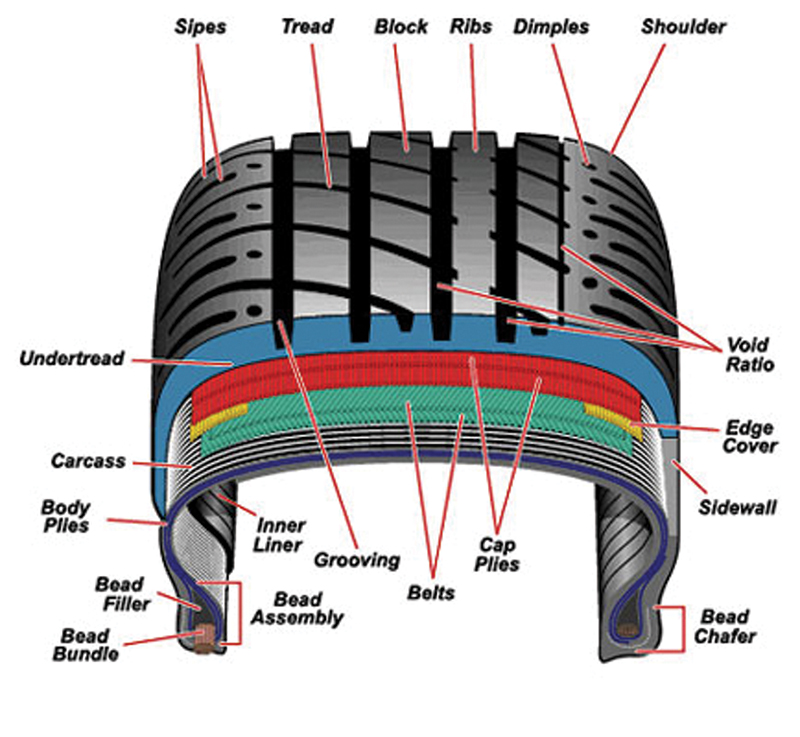
Many people keep tire plug kits in their vehicles for emergency roadside repairs, but patches are a little more in-depth. In order to properly install a patch, the tire must be safely removed from the vehicle and the rim. The hole or tear area must be cleaned up and covered with vulcanized cement so that the patch can be installed from the inside and sealed before the tire is reinstalled on the vehicle.
The patch adheres to the tire’s material around the damage, and the added pressure of inflation actually works to press the patch outward further plugging the hole. If done correctly, this creates a seal that can last the rest of the tire’s life. Patches are viable for repairing small holes or tears, generally, those that are 1/4 inch or less.
Fixing Damage in the SidewallIf you have a leak, hole or tear in your sidewall as opposed to your tread, you should not repair it with a patch.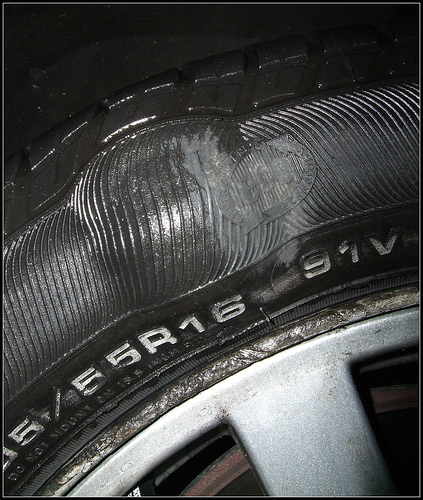 The thinness of the sidewall gives little material for a patch to adhere to, and the damage to the sidewall leaves the tire structurally compromised. As mentioned before, the sidewall tends to flex, putting extra stress on the repair and increasing the likelihood of patch failure, which is more likely to occur at higher speeds and pressures.
The thinness of the sidewall gives little material for a patch to adhere to, and the damage to the sidewall leaves the tire structurally compromised. As mentioned before, the sidewall tends to flex, putting extra stress on the repair and increasing the likelihood of patch failure, which is more likely to occur at higher speeds and pressures.
Patching the sidewall is simply not a good idea, as a leak or blowout while the vehicle is underway could result in loss of control with catastrophic consequences. So if you end up with a damaged tread, you can plug and patch away, but if the damage is to your sidewall, you’re going to have to replace the tire, which usually means replacing the fronts or rears in pairs.
So can you patch the sidewall of a tire? The answer is a solid no. Luckily, sidewall damage is far less common than damage to the tread, and you can minimize it by paying attention to road conditions, not overloading your vehicle, staying away from the curb when you’re parallel parking, and keeping your tires properly inflated, rotated and maintained.![]()
Check out all the tires, wheels and accessories available on NAPA Online, or trust one of our 17,000 NAPA AutoCare locations for routine maintenance and repairs. For more information on patching tires, chat with a knowledgeable expert at your local NAPA AUTO PARTS store.
Photos courtesy of Blair Lampe.
Blair Lampe is a New York-based professional mechanic, blogger, theater technician, and speechwriter. In her downtime she enjoys backpacking wherever her boots will carry her, rock climbing, experimental theatre, a crisp rosé , and showering love on her 2001 Sierra truck.
90,000 here are you yourself (and you can’t) - the magazine for the wheel ofLADA
UAZ
KIA
Hyundai
Renault
Toyota
Volkswagen
Skoda
Nissan
BM -Benz
Mitsubishi
Mazda
Ford
All brands
Most often, we ourselves are to blame for the fact that tires become unusable. But this can be avoided.
Related materials
You have never seen such tires: even the police were surprised
In the process of using a tire, a variety of damages can occur, most of which are the fault of the driver. As a result, rubber is wasted, and since the law prohibits the use of different tire models on the same axle, you have to spend money on replacing the second tire.
The most common damage is puncture . This is the most harmless type of damage, but only if you notice it in time and repair it right away. It is absolutely impossible to drive on a flat tire, even a couple of meters! The damage caused by running on a flat tire or with low pressure is catastrophic. This causes the sidewalls to deform more than they should, which causes the tire to overheat, delaminate, and the carcass becomes unusable due to broken cords. As a result, the tire will have to be thrown away. In addition, the edge of the rim can also be damaged. nine0003
Punctures are of two types: with and without cord damage.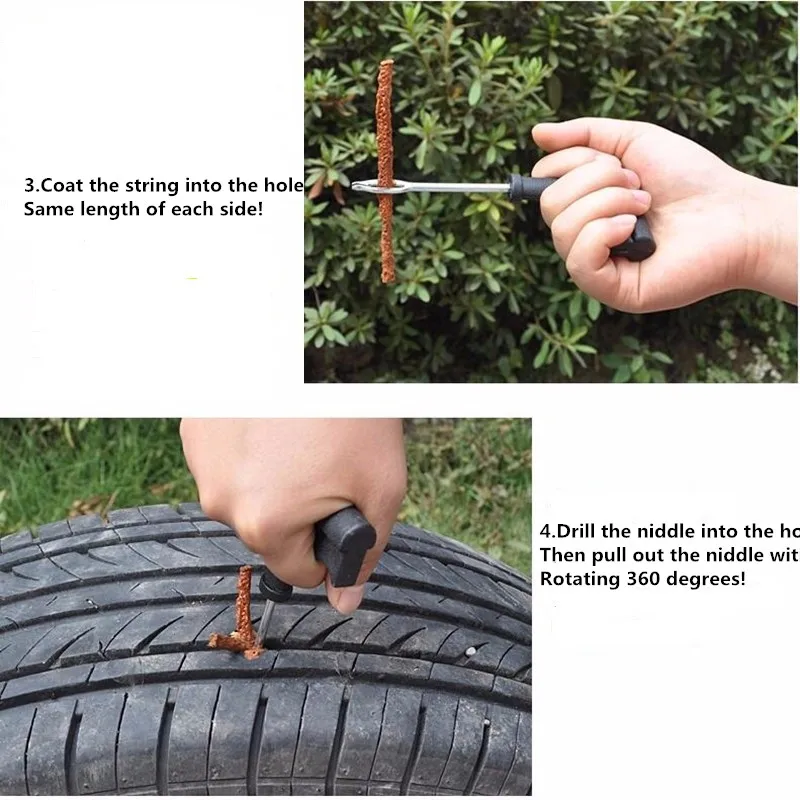 To determine this, it is necessary to remove what pierced it. If the edges of the puncture tightly converge, then the cord is not damaged and it will be possible to repair the tire without removing it from the disk. Otherwise, if the edges do not converge, you will have to disassemble the wheel and make repairs with strengthening the frame from the inside. Alternatively, in the field and in the absence of a spare wheel, such a puncture can be repaired without removing the tire from the rim, after which you can carefully drive to a tire fitting or garage and make a full repair. nine0003
To determine this, it is necessary to remove what pierced it. If the edges of the puncture tightly converge, then the cord is not damaged and it will be possible to repair the tire without removing it from the disk. Otherwise, if the edges do not converge, you will have to disassemble the wheel and make repairs with strengthening the frame from the inside. Alternatively, in the field and in the absence of a spare wheel, such a puncture can be repaired without removing the tire from the rim, after which you can carefully drive to a tire fitting or garage and make a full repair. nine0003
Related materials
Is it possible to pump up a wheel without a compressor - the experiment "Behind the wheel"
When repairing, the puncture site should be cleaned and marked. Further, it all depends on what kind of repair kit you have - as a rule, instructions are attached to them. There are sealants that are poured into the tire through the nipple, after which the wheel turns with the puncture down and the substance seals the hole.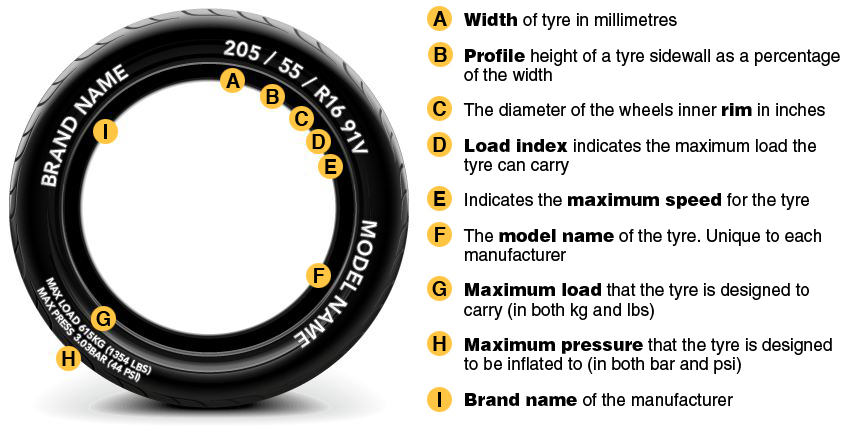 Repair using a tourniquet or insert is somewhat more complicated, but also more durable: the edges of the hole are polished with a special tool, after which the tourniquet treated with a special compound must be inserted into the tire through a puncture with a special awl, pulled out (not completely) out and cut flush with the surface. nine0003
Repair using a tourniquet or insert is somewhat more complicated, but also more durable: the edges of the hole are polished with a special tool, after which the tourniquet treated with a special compound must be inserted into the tire through a puncture with a special awl, pulled out (not completely) out and cut flush with the surface. nine0003
In case of damage to the cord due to a puncture, the tire must be removed from the rim in order to install a reinforced patch with an additional cord on its inner surface. One of the sides of such patches has an adhesive layer that promotes cold vulcanization. After such a repair, wheel balancing will be required. To seal punctures from the inside, patches in the form of a mushroom are also used, with a leg that goes into the puncture. Such patches are also covered with a special adhesive for cold vulcanization. nine0003
Cuts or holes , unlike punctures, are not repairable, as they violate the integrity of the frame, which can no longer be strengthened. In addition, breakdowns are always sudden and occur on the go: the tire abruptly loses pressure and before the car comes to a complete stop it has time to make several revolutions “on the rims”, which breaks the cord and destroys the layers. It is not recommended to use such a weakened tire, even if it was possible to repair and strengthen the place of the rupture or cut, in the future.
In addition, breakdowns are always sudden and occur on the go: the tire abruptly loses pressure and before the car comes to a complete stop it has time to make several revolutions “on the rims”, which breaks the cord and destroys the layers. It is not recommended to use such a weakened tire, even if it was possible to repair and strengthen the place of the rupture or cut, in the future.
Related materials
8 tire storage rules - do you follow them all?
Incorrect storage of tires can cause cracks . The danger of such damage is that moisture enters the cord through cracks, which renders the frame unusable. In addition, air can escape through cracks. Unfortunately, cracks are not repairable, and tires with them will not last long: sooner or later they will deform, become covered with swellings due to rusted and torn cord or because of driving with pressure below the recommended one. nine0003
Blisters or bulges can appear on a tire for a variety of reasons - it always happens due to a broken cord or delamination in the carcass. In the first case, an obstacle was hit and the impact broke the cord or the cord was cut through with a sharp object. In the second case, there is no damage on or near the hernia, which means that it appeared either due to a factory defect, or due to frequent driving with pressure below the recommended one. The danger of hernias is that they can explode at any moment and provoke a skid, which will lead to an accident. If there is nothing to replace a tire with a hernia, then it is better to rearrange it to the rear axle and drive very carefully. Like cracks, a hernia cannot be repaired. Sometimes small blisters resulting from impacts or cuts are reinforced with reinforced patches, but there is no guarantee that the tire will not explode. Therefore, tires with hernias are recommended to be replaced immediately. nine0003
In the first case, an obstacle was hit and the impact broke the cord or the cord was cut through with a sharp object. In the second case, there is no damage on or near the hernia, which means that it appeared either due to a factory defect, or due to frequent driving with pressure below the recommended one. The danger of hernias is that they can explode at any moment and provoke a skid, which will lead to an accident. If there is nothing to replace a tire with a hernia, then it is better to rearrange it to the rear axle and drive very carefully. Like cracks, a hernia cannot be repaired. Sometimes small blisters resulting from impacts or cuts are reinforced with reinforced patches, but there is no guarantee that the tire will not explode. Therefore, tires with hernias are recommended to be replaced immediately. nine0003
Related materials
Tire blackening - 6 ways to polish. Inexpensive!
Tire sidewalls can be damaged by rubbing against curbs or the asphalt edge when pulling over. If you are prone to such a driving style, then it is recommended to inspect the inner and outer sidewalls from time to time and, if abrasion is found, swap the wheels in order to prevent the cord from being exposed - the rubber thickness on the sidewalls is small (1.5–3 mm), and it can be rubbed to the frame very quickly. nine0003
If you are prone to such a driving style, then it is recommended to inspect the inner and outer sidewalls from time to time and, if abrasion is found, swap the wheels in order to prevent the cord from being exposed - the rubber thickness on the sidewalls is small (1.5–3 mm), and it can be rubbed to the frame very quickly. nine0003
Often the cause of tire damage can be poor-quality tire fitting , during which the bead ring was damaged. In this case, the tire loses its geometry and “sits” crookedly on the disk - it writes out “eights” during rotation, and lateral vibration appears during the ride. It is impossible to repair such a tire - you need to replace it with a serviceable one as soon as possible before it damages the suspension: rods, hubs and bearings.
You can find out whether you are using tires correctly and what invisible damage they have received by the characteristic wear of the tread, the varieties of which are collected in the table for convenience:
Double side shoulder wear
Driving with lower than recommended tire pressure.
Inflate the tires to the pressure recommended by the automaker (a plate with recommendations is attached in the driver's door opening) and find the cause of the fall: puncture, cracks, hernia, nipple, rust on the disc rim in the place where the tire fits, etc.
Center wear
Tire pressure too high.
Reduce the pressure to the recommended (indicated on the tablet in the driver's doorway)
In the form of rings and furrows
can be found on trailers or rear wheels of pickups and vans due to vibrations and vibrations and vibrations due to vibrations and vibrations bouncing at high speeds.
Changing wheels on a loaded axle to equalize wear, driving with a heavier load. nine0003
Chipped wear with cuts
Frequent wheel spin on rocky surfaces.
Move the wheels to a non-driving axle, use the gas pedal more carefully when starting to move.
Photo: Petr Urbanek / Unsplash
Our new video
Chinese DFSK EC35 will replace Largus?
Mustang engine and 300 mm ground clearance - a cool "UAZ" from America
Which SUV is cooler? Now we know the answer
Did you like the note? Subscribe and you will always be in the know!
Driving in Zen
News smi2.ru
Introduction
The most common operational tire defects and how to deal with them
Protector distortion
Lump (hernia)
Crack on the side
Uneven wear
Dents on the tread
Cut and puncture
Tread delamination
Spot wear
Diagonal dent
Tread break
Conclusion
Tires, as the busiest and most vulnerable part of a car, are regularly subjected to enormous stress and wear in contact with the track surface. The number of defects and damages, both hidden and obvious, is incalculable. Most of them are caused by improper use of rubber, manufacturing errors or problems with adjacent parts. In the latter case, simply replacing the tires will definitely not solve the problem. We have compiled a short list of "popular" tire problems for cars and provided methods to fix them. nine0003
The number of defects and damages, both hidden and obvious, is incalculable. Most of them are caused by improper use of rubber, manufacturing errors or problems with adjacent parts. In the latter case, simply replacing the tires will definitely not solve the problem. We have compiled a short list of "popular" tire problems for cars and provided methods to fix them. nine0003
The surface is deformed with varying degrees of localization. Sometimes a defect in the operation of tires goes beyond their metal parts. This is caused by delamination of the inner layer due to either frequent overloads and shock loads, or corrosion of steel components. Moisture gets inside through microcracks, which causes this defect. This is an extremely serious damage, which does not imply either the further use of rubber or its elimination in tire fitting, since the internal parts of the structure are affected. All that remains is to put in a new one, and hand over the damaged one for recycling. nine0003
nine0003
There are only two methods for preventing such damage: monitor pressure, avoid overloading, and regularly inspect tires for such defects. It may happen that such a tire is not the only one, and one of its neighbors has similar troubles in varying degrees of neglect.
A rounded bump may form on the sidewall or on the work surface. The most common cause of a defect in damage to the internal structure of the tire (cord) is the rupture of synthetic threads as a result of overheating at low pressure or due to severe shock loads (unsuccessful hitting a curb, an accident, fast driving over bumps). The problem is exacerbated if the tire is still over-inflated, as some drivers advise, which, they say, improves handling and helps reduce fuel consumption. This is true, but the reverse side of such “savings” is increased wear of rubber, i.e. as a result, the car owner will pay much more by correcting defects. nine0003
If the tubercle on the sidewall is practically invisible to the eye (up to 20 mm), then the malfunction can be eliminated in the tire center using a special patch, which will be placed from the back of the tread.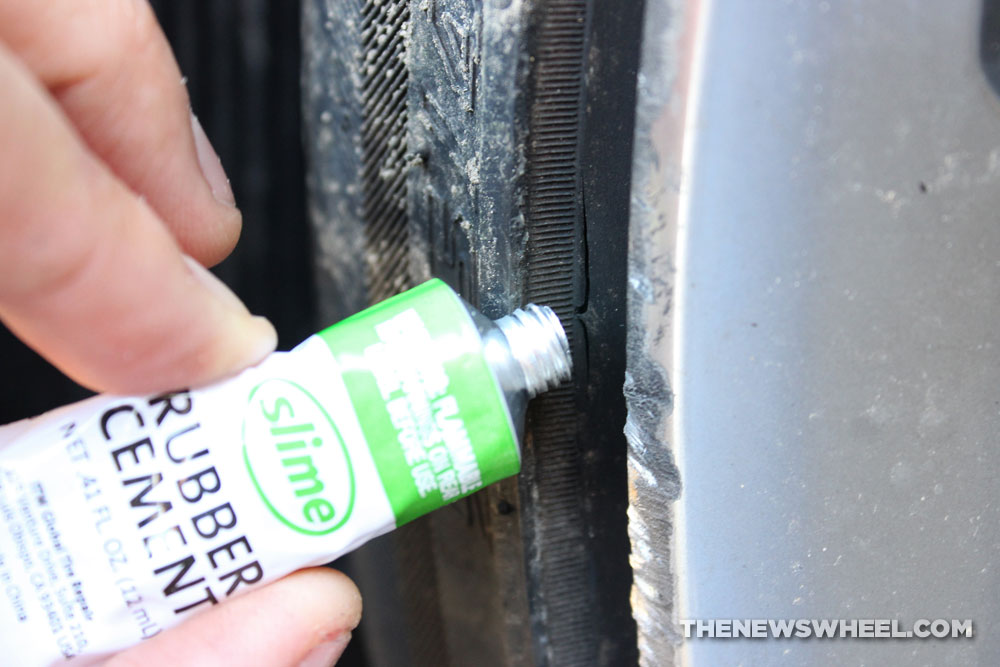 Additionally, you can straighten the disc, as it could bend after damage. But if the size of the hernia on the sidewall exceeds 15-20 mm, the tire will have to be replaced immediately, since the defect will only increase with each trip, which will eventually result in severe wear and tear on the go. nine0003
Additionally, you can straighten the disc, as it could bend after damage. But if the size of the hernia on the sidewall exceeds 15-20 mm, the tire will have to be replaced immediately, since the defect will only increase with each trip, which will eventually result in severe wear and tear on the go. nine0003
A dense network of cracks of different sizes appear on the sidewall of the tires. Such damage usually occurs in old tires, or those that have not been stored properly. High temperatures, humidity, direct sunlight, wear, positioning errors (for example, if they are simply piled on top of each other, which is prohibited for simple rubber without rims) lead to surface destruction and cracking of the sidewalls and the working area. These tires have a gray or greenish tint. If the crack runs along the rim of the wheel, then this directly indicates a lack of pressure. nine0003
Repairing an "aged" tire is not very smart, sometimes it's cheaper to buy a new one. Use or not - you can only judge by the depth of these cracks. If the sidewall damage is not too serious, then the tire can still be used for a couple more seasons, but it is still better to replace it soon, before the cracks get deeper.
Use or not - you can only judge by the depth of these cracks. If the sidewall damage is not too serious, then the tire can still be used for a couple more seasons, but it is still better to replace it soon, before the cracks get deeper.
The running surface wears unevenly in certain places, which quickly leads to failure of the entire tire, even if most of the tire does not have serious damage. nine0003
Divided into five types of defects:
Wear on one side. Rubber slides off the edge in an even layer without any bumps, abrasions and tears, while the center is relatively intact. Typically, such a defect is formed due to incorrect adjustment of the vertical angle of the wheel - camber, but it can also be caused by other problems with the suspension (wear of springs, hinges, suspension bushings, etc.). You can fix this technical problem only by contacting the tire center, where they will competently adjust the wheel alignment on a professional optical stand. This procedure is quite complicated, it is better not to do it yourself unless you are a technical specialist. nine0003
This procedure is quite complicated, it is better not to do it yourself unless you are a technical specialist. nine0003
Wear in the middle. Rubber wears out mainly in the central zone, since here the contact with the track is much stronger than on the sides. Because of this, traction is much worse. The main cause of uneven damage is over-inflation of tires, which often occurs if the driver does not control the pressure in cold weather or during sudden changes in temperature. Eliminating the defect is quite simple even with your own hands: you just need to adjust the pressure in all tires. nine0003
Side wear. The rubber wears off on the shoulder areas, giving them a more rounded shape. The cause of the defect is low pressure due to frequent trips in an overloaded state or shock loads. You can repair the damage in the same way as in the previous case: add pressure and adjust all wheels to the same level. To prevent this from happening again, you should avoid carrying heavy loads and drive more carefully.
To prevent this from happening again, you should avoid carrying heavy loads and drive more carefully.
Wavy wear. Damage in different places in the form of a spot or wave. Most often, this defect is typical for the rear axle of the car due to incorrect wheel geometry and suspension problems. Most likely, the alignment is broken, which can only be corrected in the tire center at a special alignment stand.
If the damage is not too severe and the depth of the grooves is more than 4 mm, then the tire can still be used successfully, provided that you have eliminated the cause of uneven wear (set the wheel alignment, eliminated excessive loads, adjusted the pressure, etc.). nine0003
On its surface there is a relief from a huge number of bumps and dents. This damage is due to serious problems with the suspension, which cannot cope with shock absorption, and as a result, most of the load falls on the wheels, which provokes additional wear. Even worse if the driver is used to driving over rough terrain. Ultimately, the load is distributed extremely unevenly, which gradually leads to such a defect. nine0003
Even worse if the driver is used to driving over rough terrain. Ultimately, the load is distributed extremely unevenly, which gradually leads to such a defect. nine0003
The only way to repair the damage is to go to a car service, where professionals will conduct a complete diagnosis of the suspension and identify the cause of tire wear (camber, shock absorbers, etc.). It is unlikely that they will help you in tire fitting, since it is already impossible to correct the shape of the tire.
The rubber has come apart in the working area or on the sidewall. If we exclude deliberate damage by an ill-wisher, then such damage, as a rule, occurs as a result of a collision with sharp objects (glass, nails, metal parts, etc.) or collisions. You can give the tire for repair, but if the depth of the “wound” of the sidewall reaches the carcass itself, then only a new tire will help. nine0003
Part of the tire is torn off due to damage to the internal structure. The reason for this defect is frequent overloads and low tire pressure. As a result, the rubber overheats, the metal insides are oxidized and the components are separated. It will not be possible to fix such technical problems in tire fitting, and the only way out here is a new tire. In the future, you should strictly adhere to the manufacturer's recommendations for the proper operation of rubber, monitor the level of wear. nine0003
The reason for this defect is frequent overloads and low tire pressure. As a result, the rubber overheats, the metal insides are oxidized and the components are separated. It will not be possible to fix such technical problems in tire fitting, and the only way out here is a new tire. In the future, you should strictly adhere to the manufacturer's recommendations for the proper operation of rubber, monitor the level of wear. nine0003
Indentation or damage in one place, usually accompanied by numerous nicks and tears at the edges. The most common cause of a defect is very sharp braking with simultaneous skidding. Vehicles without ABS are particularly susceptible to this type of damage because they do not have anti-skid protection. More dents can appear on cars that have been in one place for a long time. Also, the matter may be in the deplorable state of the brake system, which requires repair of the wheels. In the future, it is not recommended to use a damaged tire, as it will cause strong vibrations and shaking, not to mention increased wear. nine0003
nine0003
The dent runs along the work area, causing uneven wear. Such a defect is typical for rear axle tires in front-wheel drive vehicles that have incorrectly set camber angles. Or the reason is that the driver overloads the trunk too often, and all the weight is constantly pressing on the rear wheels, causing damage. It's unlikely to fix the dent.
nine0222
There are tears and cracks on the blocks or on the side. This usually occurs among lovers of drifting and aggressive driving on winding and broken roads. This style of driving significantly reduces the service life, leads to numerous damage to the working area and heavy wear. Rubber will still serve if it does not have deep cracks, however, if you do not change your habits, then in the end the tire will simply explode on the go. In the future, uneven, grainy asphalt pavements should be avoided. nine0003
The most common cause of all defects is too much or too little pressure.